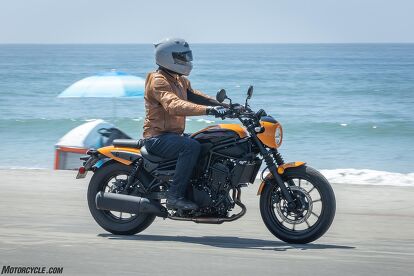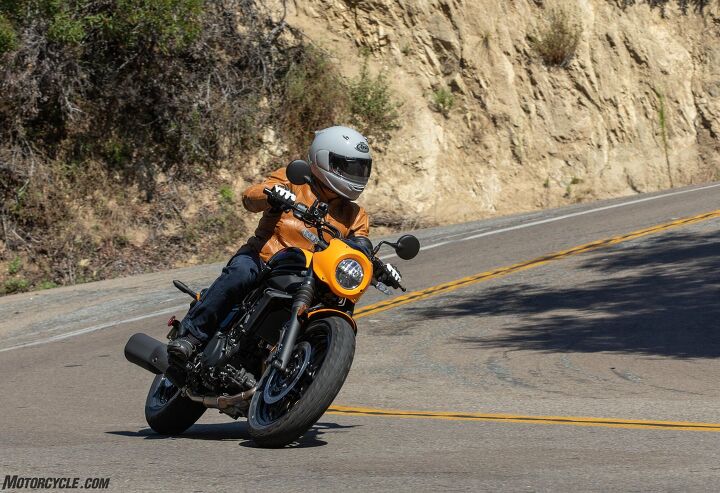2024 Kawasaki Eliminator Review – First Ride
The Vulcan S Now Has A Sibling
Once upon a displacement, 250 cubic centimeters was the unofficial beginner bike size of Japanese OEMs. Kawasaki upset that apple cart with the introduction of the Ninja 300 in 2013. Two years later, Honda and Yamaha responded with the CBR300R and YZF-R3, respectively. In 2018, the Ninja 400 retired the Ninja 300, and Kawasaki has since expanded its 400cc offerings to include the Z400 and ZX-4RR. Enter now the 451cc Eliminator, and if rumor becomes truth, a Versys 400 is on the way.
2024 Kawasaki Eliminator
Stroke a Ninja 400 engine to 451cc, wrap it in a trellis frame, style the bike as a tribute to the Vulcan S, then revive a name that’s been in and out of use since the mid-80s, and you’ve got the 2024 Kawasaki Eliminator.
Editor Score: 83.0%
Engine | 17.25/20 | Suspension | 12/15 | Transmission | 8.5/10 |
Brakes | 7.75/10 | Instruments | 3.5/5 | Ergonomics | 8.5/10 |
Appearance | 8.5/10 | Desirability | 8/10 | Value | 9/10 |
Highs
- 451cc parallel-Twin
- Low weight
- Value for the money
Sighs
- 180-degree crank
- Small instrument cluster
I could be wrong, but I think Kawasaki always had motorcycles of 400cc displacement as the company’s target. The minimal increase from 250cc to 300cc was nothing more than a diversion meant to torment its competitors while Kawasaki worked on its armada of 400cc models. Kawasaki knew that a 250cc or 300cc motorcycle would never be seen as anything more than a beginner bike, whereas a 400cc is much better equipped to attract a broader swath of riders.
Motorcycle.com would like to thank Motorcycle Mechanics Institute | MMI for sponsoring this video.
Were the new 2024 Eliminator a 250cc motorcycle, I’d have spent the press launch yawning at its power production and feeling nearly obligated to say what a great beginner bike it is. But, with an all-new liquid-cooled, DOHC, eight-valve, 451cc parallel Twin powering the Eliminator, I truly enjoyed my time aboard the sport cruiser and came away impressed with Kawasaki’s newest model. Yes, the Eliminator is a great choice for beginner motorcyclists, but also for intermediate riders, and will even keep an experienced sportbike jockey like myself entertained.
Based on the Ninja 400 engine, the Eliminator’s mill retains the same bore of 70.0mm while its increased displacement (451cc vs 399cc) comes from its increased stroke of 51.8mm from the Ninja to 58.6mm for the Eliminator. The change was meant to increase low-end torque, which it does, going from the Ninja’s 24.6 lb-ft up to a claimed 31.7 lb-ft for the Eliminator. However, it’s a sportbike engine, and it really comes alive with revs.
It needs to be said right away that, like the Ninja 400, the Eliminator’s mill does not employ a 270-degree crank that all the popular bikes are outfitted with nowadays. The 180-degree crank it does have makes some seriously fun power as it sweeps past 6,000 rpm on the way to its 12,000 rpm redline. The horsepower builds in a smooth, linear fashion, but if Kawasaki really wanted an engine with a torquey nature, it would have adopted the 270-degree crank.
The Eliminator is ergonomically arranged to fit an abundance of riders. While its 28.9-inch seat height is welcoming to shorter inseams, it should be noted that its stablemate, the 649cc Vulcan S, enjoys a stock seat height of 27.8 inches. The Vulcan S accomplishes this lower seat height by way of forward-positioned footpegs compared to the Eliminator’s mid-mount footpeg placement. The mid-mounted footpegs provided better control of the motorcycle, compared to the Vulcan S, without cramping my 5’11” stature. Overall I found the Eliminator’s rider triangle to be perfectly well-suited for an all-day jaunt with a rider of my size, and when I inquired with some of the female journos attending the event, they also praised the Eliminator’s ergos. Kawasaki’s accessories catalog for the Eliminator includes an optional low seat and high seat that decreases or increases seat height by one inch, respectively.
In very cruiserish fashion, the Eliminator is outfitted with an 18-inch front wheel wearing a 130/70 tire while a 16-inch wheel resides out back wrapped in a 150/80 tire. The fat rubber doesn’t impede handling, as the motorcycle performed well when navigating the twisty canyon roads of San Diego County. Helping maintain the Eliminator’s neutral handling manners is its steel trellis frame and rake and trail figures of 30° / 4.8 in., which is one degree less rake than the Vulcan S. The one degree of less rake is made more substantial considering the Eliminator’s wheelbase stretches two inches less between tire contact patches (59.8 inches for the Eliminator vs 62.0 inches for the Vulcan S). One of the largest contributors to the Eliminator’s maneuverability is its low curb weight. Tipping the scales at 386 pounds fully fueled has the Eliminator weighing as much as a Versys-X 300 and a whopping 110 pounds less than the Vulcan S.
The non-adjustable, 41mm, hydraulic, telescopic fork has 4.7 inches of travel and seemed well-measured considering the type of motorcycle the Eliminator is and the $6,649 price point it's at. The dual rear shocks have preload adjustability via a stepped system and provide 3.5 inches of travel. The Vulcan S is outfitted with a similar nonadjustable 41mm telescopic fork with 5.1 inches of travel, and a lay-down rear shock with linkage, preload adjustability, and 3.2 inches of travel.
Braking performance from the single, 310mm front brake disc and dual-piston caliper and 240mm rear disc with a dual-piston caliper was also commendable, hauling the Eliminator from gallop to trot in a short distance. Again comparing it to the Vulcan S, the Eliminator’s 310mm front disc is 10mm larger than the Vulcan S, while the Eliminator brakes are slowing 110 pounds less curb weight than the Vulcan S.
The LCD instrument cluster is on the small side and not nearly as attractive as a TFT display, but it packs all the information you’d expect, including a speedometer, tachometer, gear indicator, clock, and fuel gauge. The rider can also toggle through a selection of dual trip meters, remaining fuel range, and average fuel consumption. The LCD gauge is also where you connect the Eliminator with Kawasaki’s Rideology app.
The app features a useful maintenance log, general bike information, the ability to record your rides and a social aspect for sharing that information. When testing the 2022 Versys 650, I recorded part of my ride with the Rideology app, and it showed that I travelled 79 miles for 1.34 hours from Orange to San Diego counties at an average speed of 54 mph. The map, however, displayed a straight line from point A to point B, and not an accurate GPS mapping of the twists and turns.
That failure has been corrected with the updated Rideology app. After choosing the Riding Log tab in the app, then selecting an individual trip the app not only displays the route I rode, but will also replay the ride, and under the “Graph” view the app will display in real-time your gear position, RPM, speed, etc.
Other standard technologies of the Eliminator that help newer riders as much as experienced ones are the Assist & Slipper clutch and the positive neutral finder. The Assist & Slipper clutch helps reduce clutch pull, which I can confirm on the Eliminator is incredibly light, while also significantly reducing rear wheel chatter during excessive engine braking. The positive neutral finder has been around for a while but remains a huge benefit to newer riders. Its operation is easy. Just downshift to first when approaching a stop. Once completely stopped, toe-up the gear shifter, and the transmission immediately goes into neutral.
For 2024 the Eliminator is available in three different versions. The non-ABS base model comes in Pearl Robotic White or Pearl Storm Gray for $6,649, while the ABS version is available in the same colors for $300 more ($6,949) and weighs an additional 2.2 pounds, 388.1 lbs with ABS and 385.9 lbs without ABS. The features of the Eliminator SE include a two-tone Candy Steel Furnace Orange/Ebony color scheme, a handlebar-mounted waterproof USB-C outlet, a color-matched headlight cowl, fork gaiters, and a two-pattern seat design. The SE comes outfitted with standard ABS and retails for $7,249.
If I’ve done my job reviewing the new 2024 Eliminator, the benefits of Kawasaki’s emphasis on 400cc displacement should now be in full focus. By weighing nearly the same as the average 300cc motorcycle but packing a much better punch with the increased performance of its 451cc engine, the Eliminator maintains approachability for new riders entering the sport of motorcycling for the first time while also bridging the gap to intermediate and experienced riders. The Eliminator, as well as the Ninja 400 and Z400, is a win/win scenario for everyone involved. Bring on the Versys 400!
In Gear

- Helmet: Arai Contour-X
- Jacket: Roland Sands Design (Discontinued)
- Gloves: Scorpion Vortex Air
- Pants: Scorpion Covert
- Boots: Alpinestars SMX-1R (Discontinued)
2024 Kawasaki Eliminator | |
|---|---|
Engine | Type 4-Stroke, Liquid-Cooled, DOHC, 4 Valve Cylinder Head, Parallel Twin |
Displacement | 451 cc |
Bore & Stroke | 70.0 x 58.6 mm |
Maximum Torque | 31.7 lb-ft @ 7,500 rpm (claimed) |
Compression Ratio | 11.3:1 |
Fuel System | DFI w/ 32 mm Throttle Bodies (2) |
Ignition TCBI with Digital Advance | TCBI with Digital Advance |
Transmission | 6-Speed with Positive Neutral Finder |
Final Drive | Sealed Chain |
Rake/Trail | 30° / 4.8 in. |
Front Wheel Travel | 4.7 in. |
Rear Wheel Travel | 3.5 in. |
Front Tire Size | 130/70-18 |
Rear Tire Size | 150/80-16 |
Wheelbase | 59.8 in. |
Front Suspension | 41mm Hydraulic Telescopic Fork |
Rear Suspension | Dual Shocks |
Front Brake Type | Single 310mm Disc with 2-Piston Balanced Actuation Caliper |
Rear Brake Type | Single 240mm Disc with 2-Piston Caliper |
Fuel Tank Capacity | 3.7 gal. |
Seat Height | 28.9 in. |
Curb Weight | 388.1 (ABS)/390.3 (ABS SE)/385.9 (Non-ABS) lb. (claimed) |
Warranty | 12 months |
Kawasaki Protection Plus™ | 12, 24, 36 or 48 months |
We are committed to finding, researching, and recommending the best products. We earn commissions from purchases you make using the retail links in our product reviews. Learn more about how this works.
Become a Motorcycle.com insider. Get the latest motorcycle news first by subscribing to our newsletter here.
A former Motorcycle.com staffer who has gone on to greener pastures, Tom Roderick still can't get the motorcycle bug out of his system. And honestly, we still miss having him around. Tom is now a regular freelance writer and tester for Motorcycle.com when his schedule allows, and his experience, riding ability, writing talent, and quick wit are still a joy to have – even if we don't get to experience it as much as we used to.
More by Tom Roderick


































































Comments
Join the conversation
No dyno graph? interesting to see the difference between the standard ninja 400 engine this bike is based on.
Sure seems that Japan has given up on making good looking bikes these days...